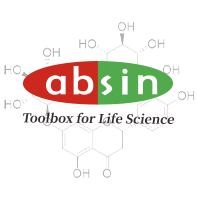Product Details
Product Details
Product Specification
| Operating Instructions | Plant tissue, animal tissue, serum (plasma) | ||||||||||||||||||||||||||||||||||||||||||||||||||||||||||||||||
| Usage |
Self-supplied consumables:
Sample preparation: 1. Plant or animal tissue samples: Said to take about 0.1 g group, add 1 mL Hydrochloric Acid, 1.5 mL deionized water, homogenate, boiling water bath for 30 min, add 1 mL of Sodium Hydroxide, blending, deionized water constant volume to 10 mL, 8000 g, 25 ℃ centrifuge for 10 min, take on the solution under test. 2, serum (plasma) samples: Take 0.1 mL serum (plasma), add 0.1 mL of Hydrochloric Acid, 0.15 mL deionized water, homogenate, boiling water bath for 30 min, add 0.1 mL Sodium Hydroxide blending, deionized water constant volume to 1 mL, 8000 g, 25 ℃ centrifuge for 10 min, take on the solution under test. Note: Protein quantification kit abs9232 (BCA assay) is recommended for protein concentration determination. Experimental procedures: 1. The microplate reader or visible spectrophotometer was preheated for more than 30 min, and the wavelength was adjusted to 540 nm. The visible spectrophotometer was zeroed with deionized water. 2, operation table, in the EP tube, in turn, to join the following reagents:
The results were calculated as follows: Note: We provide you with the calculation formula, including the derivation process calculation formula and the concise calculation formula. The two are exactly the same. The concise formula in bold is recommended as the final formula. 1. Drawing of the standard curve The standard curve was plotted with the concentration of the standard on the Y-axis and the ΔA standard on the X-axis. Will be Δ A measurement into the formula to calculate the y value (mg/mL). 2, sample calculated total sugar content (1) according to the sample quality is calculated Total sugar (mg/g)=(y×V sample)÷(W×V sample ÷ total V sample)×n=10×y÷W×n (2) calculated according to the protein concentration of the sample Total sugar (mg/mg prot) = (x y V sample) present sample (V (Cpr) * n n = y present Cpr (3) according to the serum (plasma) volume calculation Total sugar (mg/mL)=y×V sample ÷(V liquid ×V sample ÷V sample total)×n=10×y×n V-like: added sample volume, 0.03 mL; The volume V sample total: tissue samples, 10 mL; Cpr: sample protein concentration, mg/mL; W: sample quality, g; V solution: liquid sample volume, 0.1 mL; The volume V sample total: liquid samples, 1 mL; n: dilution factor |
||||||||||||||||||||||||||||||||||||||||||||||||||||||||||||||||
| Theory | Carbohydrate is one of the important components of animals and plants, and is also the main raw material and storage material for metabolism. "Total sugars mainly refer to glucose, fructose, lactose, which are reduced, and sucrose, maltose, which can be hydrolyzed to reduced monosaccharides under the measured conditions, and starch, which may be partially hydrolyzed." The total sugar content detection kit (micromethod) can detect the total sugar content in liquid samples such as animal and plant tissues and serum (pulp). Its principle is to hydrolyse the total sugar into reducing sugar, which reduces DNS to amino compounds after co-heating with DNS reagent under alkaline conditions. In a certain concentration range, the reducing sugar content is linear with the absorbance at 540 nm. According to the standard curve, the total sugar content in the sample can be calculated. | ||||||||||||||||||||||||||||||||||||||||||||||||||||||||||||||||
| Synonym | Micro Total Carbohydrate Assay Kit | ||||||||||||||||||||||||||||||||||||||||||||||||||||||||||||||||
| Description | Sensitivity: 0.1 mg/mL |
||||||||||||||||||||||||||||||||||||||||||||||||||||||||||||||||
| Composition |
|
||||||||||||||||||||||||||||||||||||||||||||||||||||||||||||||||
| Background | Total sugars mainly refer to glucose, fructose, lactose, which are reduced, and sucrose, maltose, which can be hydrolyzed to reduced monosaccharides under the measured conditions, and starch, which may be partially hydrolyzed. Carbohydrate is one of the important components of animals and plants, and is also the main raw material and storage material for metabolism. | ||||||||||||||||||||||||||||||||||||||||||||||||||||||||||||||||
| General Notes | 1. Do not mix the components between different batch numbers and different manufacturers; Otherwise, it may lead to abnormal results. 2, when mixing or redissolving the components, avoid air bubbles. 3, frequently change the suction head to avoid cross contamination between the components. 4, before the experiment, ensure that all the components and equipment are at the right temperature. 5. Before the experiment, it is recommended to select 2-3 samples with large expected differences for pre-experiment. If the absorbance value of the sample is not within the measurement range of the standard curve, it is recommended to dilute or increase the sample size for detection, and multiply the result by the dilution. 6, Hydrochloric Acid and Sodium Hydroxide are corrosive, DNS Reagent has certain toxicity, please take protective measures during operation. 7, this kit for cellulose decomposition degree can not reach 100%. |
||||||||||||||||||||||||||||||||||||||||||||||||||||||||||||||||
| Storage Temp. | 2-8 ° C, stored in the dark, valid for 12 months. |
||||||||||||||||||||||||||||||||||||||||||||||||||||||||||||||||
| Test Range | 0.1-2 mg/mL | ||||||||||||||||||||||||||||||||||||||||||||||||||||||||||||||||
| Applications | Plant tissue, animal tissue, serum (plasma) | ||||||||||||||||||||||||||||||||||||||||||||||||||||||||||||||||


